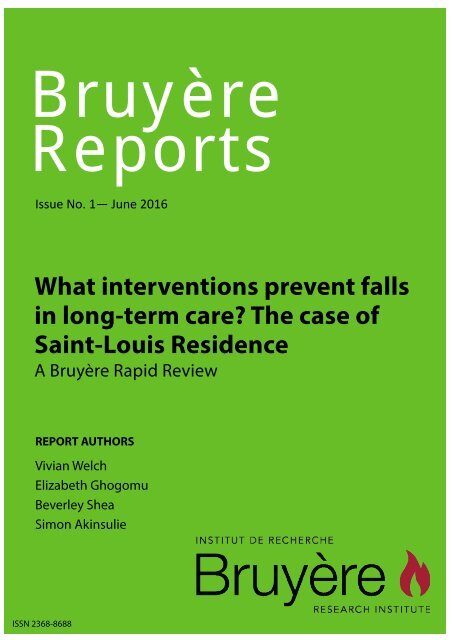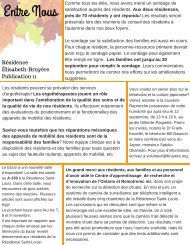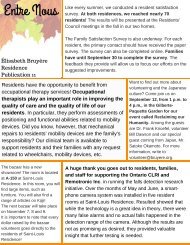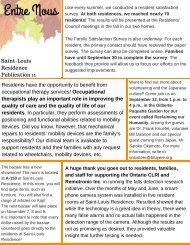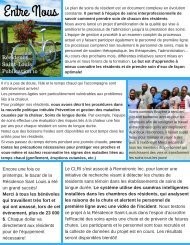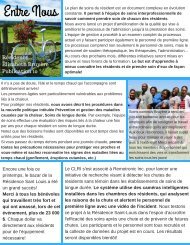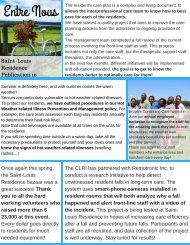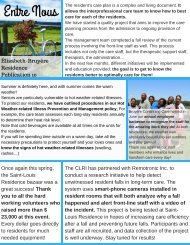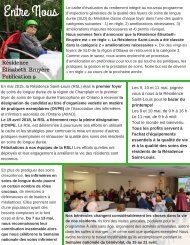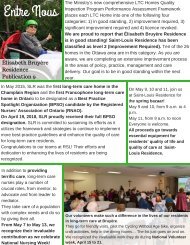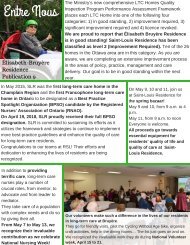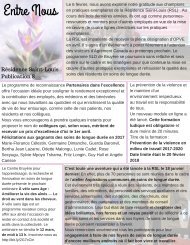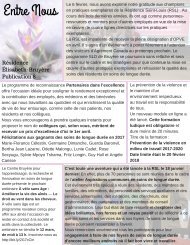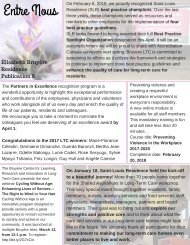Bruyere Reports - Falls RSL
Create successful ePaper yourself
Turn your PDF publications into a flip-book with our unique Google optimized e-Paper software.
Bruyère<br />
<strong>Reports</strong><br />
Issue No. 1— June 2016<br />
What interventions prevent falls<br />
in long-term care? The case of<br />
Saint-Louis Residence<br />
A Bruyère Rapid Review<br />
REPORT AUTHORS<br />
Vivian Welch<br />
Elizabeth Ghogomu<br />
Beverley Shea<br />
Simon Akinsulie<br />
ISSN 2368-8688
2
Contents<br />
Key messages 3<br />
Executive summary 4<br />
Context of falls at Saint-Louis Residence 5<br />
Evidence review 7<br />
Gap analysis 10<br />
Discussion of evidence review: strengths and limitations 11<br />
Inferences and next steps 12<br />
References 14<br />
Key messages<br />
<br />
Evidence from available long-term care Minimum Data Set (MDS) data and staff perception<br />
show that cognitive impairment and mobility status are common risk factors<br />
for falls at Saint-Louis Residence that could be considered in falls prevention strategies.<br />
<br />
Factors contributing to the high rates of falls included client and environmental factors<br />
such as cognitive impairment, lack of safety inspection of ambulatory devices,<br />
as well as organization of care factors, e.g., limited occupational therapy.<br />
<br />
<strong>Falls</strong> prevention interventions including falls risk assessment on admission and after<br />
a fall, multifactorial interventions, client and staff education as well as strength and<br />
balance training have been recommended in previous guidelines.<br />
3
Executive summary<br />
<strong>Falls</strong> are a major public health problem<br />
among seniors. Health Quality Ontario (HQO)<br />
set benchmarks for quality indicators to enable<br />
comparison of performance between long<br />
-term care (LTC) facilities and encourage<br />
quality improvement. The quality indicator<br />
used to monitor falls in LTC is the percentage<br />
of residents who fell in the last 30 days. The<br />
rate of falls at Saint-Louis Residence (SLR) is<br />
higher than the HQO benchmark of nine per<br />
cent.<br />
To investigate the reasons for the high rate of<br />
falls at SLR, we examined available data, conducted<br />
staff interviews as well as an evidence<br />
review on risk factors for falls and the effectiveness<br />
of falls prevention interventions in<br />
LTC.<br />
Available data and staff perceptions showed<br />
that the top two risk factors present at SLR<br />
where actions could be taken are cognitive<br />
impairment and mobility status. Most of the<br />
falls occurred during the day and evening<br />
shifts when residents are awake and active.<br />
Factors contributing to the high rates of falls<br />
included client and environmental factors<br />
such as cognitive impairment, lack of safety<br />
inspection of ambulatory devices, as well as<br />
organization of care factors, e.g., limited occupational<br />
therapy.<br />
<strong>Falls</strong> prevention interventions including falls<br />
risk assessment on admission and after a fall,<br />
multifactorial interventions, client and staff<br />
education, as well as strength and balance<br />
training have been recommended in previous<br />
guidelines. The preventive interventions<br />
where data from SLR identifies actionable<br />
gaps are multifactorial interventions tailored<br />
to client and family needs, as well as strength<br />
and balance training.<br />
Based on the evidence, we recommend the<br />
following strategies to reduce falls rates at<br />
SLR:<br />
1. Improve data for monitoring impact of<br />
changes.<br />
2. Prioritize interventions based on data and<br />
needs; including client and staff education,<br />
falls risk assessment and multifactorial<br />
interventions along with continuing existing<br />
good practices such as vitamin D<br />
and medication review.<br />
3. Communication between SLR and Élisabeth<br />
Bruyère Residence (EBR), as well as<br />
within SLR across different disciplines.<br />
4. Human resources alignment with peak<br />
periods, e.g., increased use of volunteers<br />
during peak periods.<br />
4
Context of falls at Saint-Louis<br />
Residence<br />
SLR is one of Bruyère’s LTC facilities with 198<br />
beds in seven units including four LTC units, a<br />
convalescent care unit and two units with<br />
special services for patients with dementia. It<br />
has three levels of staff with a staffing ratio of<br />
one staff to ten patients.<br />
Resident characteristics<br />
SLR has a sicker and frailer population than<br />
the average LTC population of Ontario, with<br />
53 per cent meeting the Cognitive Performance<br />
Scale (CPS) criteria of severe impairment<br />
compared to the average LTC Ontario<br />
population where only 28 per cent meet this<br />
level. There is also a larger proportion of<br />
women (82 per cent) vs. 62 per cent in the<br />
average Ontario LTC residence.<br />
1 to September 25, 2014. Of these, 21 per<br />
cent were witnessed; 57 per cent were found<br />
on the floor. Of the 300 falls, 45 per cent were<br />
attributed to loss of balance. The three most<br />
common positions from which people fell<br />
were standing position (22 per cent), chair (21<br />
per cent), and wheelchair (19 per cent). Injuries<br />
were reported for 17 per cent of the falls<br />
(51 falls), with five per cent of these injuries in<br />
the head and neck region, and 0.7 per cent<br />
assessed as serious.<br />
Most of the falls occurred in the day shift<br />
(44.3 per cent) and evening shift (41.3 per<br />
cent) when residents are awake and active;<br />
only 14.3 per cent at night. When plotted according<br />
to time, there are peaks in falls at 7<br />
a.m., 10 a.m., 3:30 p.m. and 7 p.m.<br />
<strong>Falls</strong> data<br />
<strong>Falls</strong> at SLR are 8.2 per cent above the HQO<br />
benchmark of nine per cent, with a percentage<br />
of residents who fell in the last 30 days of<br />
17.2 per cent. There may be a higher proportion<br />
of falls in the dementia units (19 per cent<br />
vs. nine per cent) according to data collected<br />
from September 2013 to March 2014. These<br />
proportions may be misleading because they<br />
are based on proportion of beds available<br />
and all beds may not be occupied.<br />
According to the Bruyère Risk Incident Management<br />
System (RIMS) data, 300 unique incident<br />
falls were reported at SLR from January<br />
PROTECTIVE MEASURES AND RISK FAC-<br />
TORS<br />
In almost half of incident falls, all protective<br />
measures in the care plan were in place (43<br />
per cent). Protective measures in the care<br />
plan most commonly identified as being in<br />
place for the fall incidents were call bells (46<br />
per cent of incident falls), low bed (32 per<br />
cent of incidents), constant care (15 per cent<br />
of incidents), and ambulation device (ten per<br />
cent of incidents).<br />
5
Of the 171 incidents where some protective<br />
measures were identified as missing, the most<br />
common missing protective measures were:<br />
low bed (16 per cent), constant care (ten per<br />
cent), alarm (ten per cent) and ambulation<br />
device (five per cent).<br />
At the time of incident falls, the top five risk<br />
factors identified on the RIMS report for these<br />
300 falls were cognitive impairment (60 per<br />
cent), mobility status (46 per cent), difficulty<br />
following instructions (37 per cent), change in<br />
cognitive status (18 per cent) and increased<br />
frequency of falling (16 per cent).<br />
SLR is one of Bruyère’s LTC facilities with 198<br />
beds in seven units including four LTC units, a<br />
convalescent care unit and two units with<br />
special services for patients with dementia. It<br />
has three levels of staff with a staffing ratio of<br />
one staff to ten patients.<br />
ENVIRONMENTAL FACTORS<br />
<br />
<br />
<br />
Low mattresses on the floor can be a tripping<br />
hazard.<br />
Wheelchairs and other equipment may<br />
not be used properly (e.g., unfixed safety<br />
belts), not regularly inspected for safety or<br />
may be absent for cleaning at times.<br />
Most falls occur at dawn or evening.<br />
ORGANIZATION OF CARE<br />
<br />
<br />
<br />
<br />
Staff feels stressed at mealtimes because<br />
of the short time to feed many residents.<br />
Communication within SLR about residents<br />
could be improved (e.g., housekeeping<br />
staff may not be aware of changes<br />
in a resident’s cognitive status).<br />
Occupational therapy limited in availability.<br />
Communication across Bruyère Continuing<br />
Care and how SLR is included because<br />
of its distance.<br />
Staff perceptions on falls at SLR<br />
A focus group discussion with the SRL staff<br />
identified the following observations:<br />
CLIENT FACTORS<br />
<br />
<br />
<br />
Staff perceives all residents to be at high<br />
risk of falling.<br />
Dementia patients push each other.<br />
Residents are impatient bringing them to<br />
take risks that lead to falls.<br />
6
Evidence review<br />
We searched for relevant systematic reviews<br />
and guidelines published between January<br />
2007 and November 2014 in Trip Database.<br />
Trip Database is an online database with<br />
links to resources for evidence-based medicine<br />
(EBM) including clinical guidelines and<br />
systematic reviews. Content is updated every<br />
two weeks from PubMed using a validated<br />
search. In addition, we examined reference<br />
lists of relevant articles and consulted experts<br />
at the Bruyère Research Institute. The<br />
search results and potentially eligible articles<br />
were screened and reviewed by two authors.<br />
The quality of eligible guidelines and systematic<br />
reviews were assessed using the Appraisal<br />
of Guidelines, Research and Evaluation<br />
(AGREE) score and the Assessing the Methodological<br />
Quality of Systematic Reviews<br />
(AMSTAR) checklist respectively.<br />
We included clinical guidelines and systematic<br />
reviews if they considered interventions<br />
to prevent falls or injuries from falls in older<br />
adults (aged 65 or more) in LTC facilities such<br />
as residential care or nursing homes, compared<br />
to usual care or other interventions.<br />
The interventions could be aimed at the staff,<br />
clients, physicians or changes to the setting<br />
such as environmental modification. We excluded<br />
guidelines and systematic reviews on<br />
interventions in community-dwelling and<br />
hospitalized populations. We also excluded<br />
those on post-fall interventions only.<br />
Evidence review: Risk factors for falls<br />
Based on a 2013 updated assessment of risk<br />
by the American College of Physicians, the<br />
most important predictors of risk of falling<br />
for LTC residents are the use of restraints<br />
(ten times higher risk), history of a previous<br />
fall (three times higher risk), systolic hypotension<br />
(two times higher risk, the presence<br />
of polypharmacy or benzodiazepines (two to<br />
seven times higher risk) and cognitive impairment<br />
(1.8 times higher risk).<br />
Evidence review: Systematic reviews of falls<br />
prevention<br />
We identified three systematic reviews (1-3)<br />
and five guidelines (4-8) with evidence focused<br />
on the long-term care setting. A 2012<br />
Cochrane review of high quality (AMSTAR<br />
score: 11/11) assessed interventions for preventing<br />
falls in older people in care facilities<br />
(1). The mean age of the participants was 84<br />
years (77 per cent women) and some studies<br />
specifically recruited participants with cognitive<br />
impairment.<br />
7
Summarizing the evidence, most interventions<br />
were conducted in an older population<br />
(mean age: 80 years). Cognitive status was<br />
not well reported, but some trials did include<br />
residents with dementia. Most results suffered<br />
from low-quality evidence (due to<br />
study limitations and imprecise estimates)<br />
from a limited number of randomized controlled<br />
trials. The interventions which were<br />
shown to prevent five or more falls per 100<br />
people per year were:<br />
Client education on personal risk factors<br />
and risk reduction strategies (in younger<br />
adults, mean age: 70).<br />
Staff education on patient safety<br />
(including falls, urinary tract infection and<br />
pressure ulcers).<br />
Interventions with evidence of benefit of less<br />
than five falls per year were: multifactorial<br />
interventions, fall risk assessment, pharmacist<br />
outreach program, brisk walking). Carpet<br />
floors (when compared to vinyl) increased<br />
fall rates in a subacute hospital.<br />
Evidence review: Clinical<br />
guidelines for fall prevention<br />
We included clinical guidelines from Canada<br />
(Registered Nurses Association of Ontario-<br />
RNAO 2011)(9), UK (NICE guidelines, 2013)<br />
(5), Australia (Australian RACF guidelines,<br />
2009)(6), the USA (AGS/BGS guidelines 2010)<br />
(7). We also assessed the ACOVE3 statement<br />
on preventing falls in vulnerable elderly<br />
(2007)(8).<br />
<br />
<br />
<br />
<br />
<br />
<br />
Strength and balance training.<br />
Medication review of all medications.<br />
Multifactorial program of low-intensity<br />
exercise, fluid for dehydration and management<br />
of urinary incontinence.<br />
Wireless position monitoring vs. usual<br />
care.<br />
Vitamin D supplementation.<br />
Staff education on patient safety<br />
(including falls, urinary tract infection and<br />
pressure ulcers).<br />
8
INTERVENTIONS RECOMMENDED BASED<br />
ON HIGH QUALITY EVIDENCE<br />
Assessment of fall risk using multiple factors<br />
(e.g., cognition, mobility, vision, medication)<br />
on admission and/or after a fall.<br />
Multifactorial interventions to prevent<br />
falls, tailored to the local context and client’s<br />
risk factors.<br />
Strength and balance evaluation and<br />
training.<br />
Home safety interventions in people with<br />
a history of falls.<br />
Psychotropic medication review and withdrawal.<br />
INTERVENTIONS RECOMMENDED, DE-<br />
PENDING ON SETTING<br />
Client education which may not be accepted<br />
by some clients.<br />
INTERVENTIONS NOT RECOMMENDED<br />
Untargeted group exercise.<br />
Brisk walking.<br />
Synthesis of fall data, evidence review and<br />
staff perceptions<br />
From the above evidence and findings, the<br />
top two risk factors present at SLR from falls<br />
data and staff perceptions where actions<br />
could be taken are cognitive impairment and<br />
mobility status. Preventive interventions including<br />
falls risk assessment on admission<br />
and post-fall, multifactorial interventions, client<br />
and staff education, strength and balance<br />
training have been recommended in previous<br />
guidelines.<br />
The preventive interventions where data from<br />
SLR identifies actionable gaps are multifactorial<br />
interventions tailored to client and family<br />
needs and strength and balance training.<br />
<br />
Staff education in falls risk and prevention.<br />
INTERVENTIONS WITH INSUFFICIENT EVI-<br />
DENCE<br />
<br />
<br />
Low intensity exercise and incontinence<br />
programs.<br />
Hip protectors.<br />
9
Gap analysis at Saint-Louis<br />
Residence<br />
A recent gap analysis by the RNAO falls prevention<br />
coordinator in 2011 showed that the<br />
SLR practice met or partially met all the<br />
RNAO Best Practice Guideline Recommendations<br />
for prevention of falls and falls injuries.<br />
Several areas of good practice were already in<br />
place in accordance with the RNAO 2011<br />
guidelines on falls prevention:<br />
risk, falls prevention measures in<br />
charts.<br />
4. Add client education for those at<br />
high risk.<br />
5. Formalize environmental assessments.<br />
6. Existing exercise programming<br />
could be increased.<br />
1. Medication review.<br />
2. Use of hip protectors.<br />
3. Vitamin D supplementation.<br />
4. Nursing education: yearly education<br />
about falls prevention.<br />
5. Policy for least restraint<br />
6. Policy for organizational support<br />
7. Policy for medication review<br />
Action areas identified were:<br />
1. Improved fall risk assessment on<br />
admission (e.g., validated tool, defining<br />
falls, completing RAPS, assessing<br />
vision, hearing).<br />
2. Assessing fall risk after fall (e.g.,<br />
neurological assessment after unwitnessed<br />
falls).<br />
3. Explicit documentation of falls, falls<br />
10
Discussion of evidence review:<br />
strengths and limitations<br />
The following four interventions were effective<br />
at reducing falls, based on systematic<br />
reviews and clinical practice guidelines: 1)<br />
Multifactorial falls risk assessment and risk<br />
reduction; 2) Multifactorial interventions; 3)<br />
Strength and balance training; 4) Psychotropic<br />
medication review and discontinuation<br />
(if appropriate).<br />
One limitation of these recommendations is<br />
that there is uncertainty about the components<br />
of multifactorial assessment or interventions.<br />
For example, multifactorial risk assessment<br />
could include identification of falls<br />
history; assessment of gait, balance and mobility,<br />
and muscle weakness; assessment of<br />
osteoporosis risk; assessment of the older<br />
person’s perceived functional ability and fear<br />
relating to falling; assessment of visual impairment;<br />
assessment of cognitive impairment<br />
and neurological examination; assessment<br />
of urinary incontinence; assessment of<br />
environmental hazards; cardiovascular examination<br />
and medication review.<br />
Client education and staff education about<br />
falls risk and falls risk reduction were not<br />
uniformly recommended by clinical guidelines<br />
and may depend on the setting, and<br />
the quality of evidence is limited by a small<br />
number of small studies.<br />
Regarding vitamin D, although there is evidence<br />
of benefit from randomized trials,<br />
there is controversy as to what dose of vitamin<br />
D should be given to prevent falls in<br />
older people, and none of the guidelines<br />
recommend vitamin D uniformly. However,<br />
there is evidence that the administration of<br />
800 UI of vitamin D in older people with risk<br />
of vitamin D insufficiency or deficiency reduces<br />
the risk of falls and fractures. The<br />
RNAO guidelines recommend vitamin D<br />
supplementation for residents since they<br />
have a risk for vitamin D insufficiency or deficiency<br />
because the production of vitamin D<br />
in the skin falls to near zero for four to five<br />
months of the year in Canada.<br />
11
Inferences and next steps<br />
Based on our review of the data from SLR<br />
and the evidence review, we propose the following<br />
recommendations.<br />
1. Data structure<br />
Bruyère Continuing Care should consider<br />
developing methods of analyzing RIMS<br />
data on falls incidents and make them<br />
available for continuous monitoring of<br />
falls prevention strategies. These methods<br />
should be able to generate a report<br />
of the number of falls, incidence of repeat<br />
fallers, associated risk factors and<br />
protective measures associated with each<br />
incident.<br />
2. <strong>Falls</strong> risk assessment<br />
Staff should consider implementing falls<br />
risk assessment tools on admission, after<br />
a fall and when there is a change in cognitive<br />
status to detect fall-prone individuals<br />
and to identify their risk factors. They<br />
can then concentrate their efforts on fallprone<br />
clients and implement strategies<br />
or interventions to reduce the occurrence<br />
of future falls.<br />
3. Staff education<br />
Bruyère Continuing Care should continue<br />
its annual staff education program about<br />
falls risk, and consider including updated<br />
RIMS data in these annual sessions on<br />
protective measures in place and missing<br />
as well as resident risk factors to learn<br />
from experience. The staff should be encouraged<br />
to implement interventions<br />
that are compatible with the client’s values,<br />
needs, wishes, preferences and risk<br />
factors.<br />
4. Client education<br />
Client education is not currently done at<br />
SLR; is in line with the move towards patient-centred<br />
care, and could be implemented<br />
with clients at high risk of falling<br />
to share risk information with the clients<br />
and their family, discuss risk reduction<br />
strategies that the resident can take to<br />
prevent falls. Staff should engage the<br />
family as well in supporting client activity<br />
and assisting in falls prevention strategies.<br />
12
5. Communication<br />
Based on staff consultation, there is a<br />
perception of a need for improved communication<br />
within SLR as well as between<br />
SLR and EBH. At SLR, communication between<br />
different health and service providers<br />
could assist in identifying people<br />
at high risk of falling and mitigating this<br />
risk. Communication across Bruyère<br />
Continuing Care (for example between<br />
SLR and EBR) could motivate staff to<br />
share experiences and strategies for improvement.<br />
could be deployed differently to cover<br />
periods of peak activity such as meal<br />
times and also shift change.<br />
6. Equipment safety checks<br />
Based on the staff consultation, there appears<br />
to be a need to review that protective<br />
measures are in place, used appropriately<br />
and in good condition (e.g.,<br />
wheelchairs and sofa chairs).<br />
7. Volunteer services<br />
Consider how volunteer services could be<br />
incorporated at peak hours (e.g., meal<br />
time and shift change) when residents<br />
are at a greater risk of falling. Also, staff<br />
13
References<br />
1. Cameron ID, Gillespie LD, Robertson MC, Murray GR, Hill KD, Cumming RG, Kerse N. Interventions<br />
for preventing falls in older people in care facilities and hospitals. Cochrane Database<br />
of Systematic Reviews 2012, Issue 12. Art. No.: CD005465. DOI:<br />
10.1002/14651858.CD005465.pub3.<br />
2. Silva RB EG, Duque G. Exercise for falls and fracture prevention in long term care facilities:<br />
a systematic review and meta-analysis. J Am Med Dir Assoc. 2013;14(9):685-9.e2.<br />
3. Neyens JC vHJ, Dijcks BP, Martens M, van den Heuvel WJ, de Witte LP. Effectiveness and<br />
implementation aspects of interventions for preventing falls in elderly people in long-term<br />
care facilities: a systematic review of RCTs. J Am Med Dir Assoc. 2011;12(6):410-25.<br />
4. Prevention of <strong>Falls</strong> and Fall Injuries in the Older Adult. Registered Nurses' Association of<br />
Ontario. 2011.<br />
5. NICE clinical guideline 161 <strong>Falls</strong>: Assessment and prevention of falls in older people. Issued<br />
June 2013.<br />
6. Preventing falls and harm from falls in older people - best practice guidelines for Australian<br />
residential aged care facilities. Clinical Practice Guidelines Portal. 2009.<br />
7. AGS/BGS clinical practice guideline: prevention of falls in older persons. [American Geriatrics<br />
Society]. info@guidelinesgov (NGC). 2010.<br />
8. Chang JT GD. Quality Indicators for <strong>Falls</strong> and Mobility Problems in Vulnerable Elders. JAGS.<br />
2007;55:S327–S34.<br />
9. Brown CJ NM, Schneider DL, Korenstein D, Lynn RB. Screening for falls. American College<br />
of Physicians. 2013. Available from http://smartmedicine.acponline.org/content.aspx?<br />
gbosID=484#<br />
14
Acknowledgements<br />
We acknowledge SLR staff who participated in the focus group discussion, Chris Sorfleet and<br />
Rachel Blais who provided the RIMS and MDS data, Manosila Yoganathan, Magnus Novell,<br />
Sasha Masabanda, and Nishali Patel who helped in the review development process.<br />
15
Copyright Bruyère Research Institute 2016. This work is licensed under the Creative Commons Attribution-NonCommercial<br />
4.0 International License. To view a copy of this license, visit http://<br />
creativecommons.org/licenses/by-nc/4.0/.<br />
Suggested citation: Welch V, Ghogomu E, Shea B, Akinsulie S. What interventions prevent falls in<br />
long-term care? The case of Saint Louis Residence. Bruyère <strong>Reports</strong> No. 1, June 2016.<br />
16


